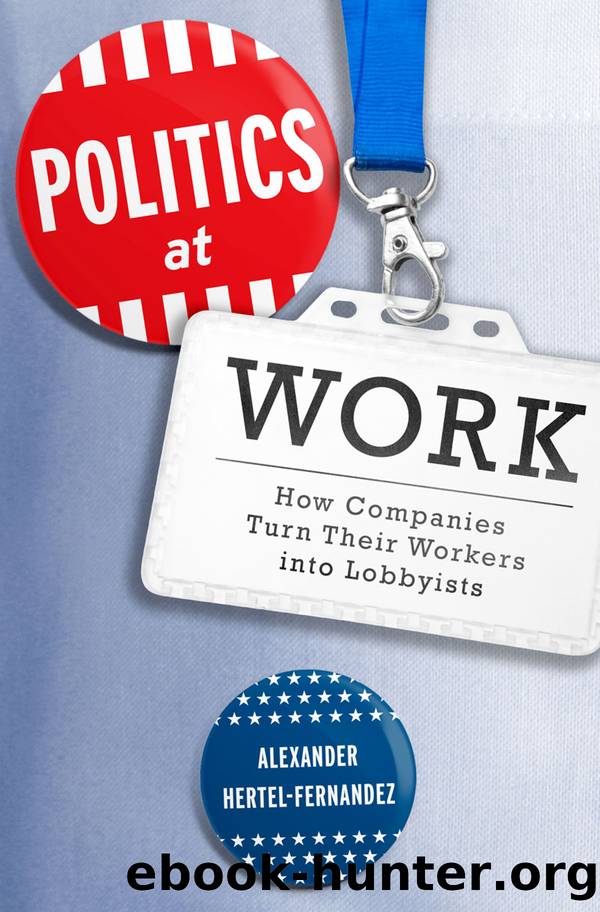Politics at Work: How Companies Turn Their Workers Into Lobbyists by Alexander Hertel-Fernandez

Author:Alexander Hertel-Fernandez [Hertel-Fernandez, Alexander]
Language: eng
Format: epub
Tags: Business & Economics, Government & Business, political science, Political Process, Campaigns & Elections, History & Theory, Labor & Industrial Relations, Political Advocacy, Social Science, sociology, Social Theory
ISBN: 9780190629892
Google: dj9FDwAAQBAJ
Publisher: Oxford University Press
Published: 2018-11-15T00:30:46.620549+00:00
Employer Mobilization and Worker Political Participation
In addition to showing how employer messages may change workersâ political attitudes and knowledge, the analysis of the CCES poll offers an opportunity to look at the effect of employer messages on political action. The CCES poll asked respondents whether they had participated in five civic activities from 2015 to 2016: voting in the 2016 election, attending a political meeting, putting up a political sign or wearing a button, making donations to political causes, and volunteering for campaigns or candidates. In all, 70 percent of workers reported performing at least one of these civic acts, and the average number of acts was one. If employer messages were indeed spurring workers to greater political action, then we ought to see that workers who had received employer contact would have reported more political acts compared to those workers who had not received employer contacts, net of other individual characteristics. Since the CCES asked about political contact from the parties or political campaigns as well as labor unions, we can also compare the effects of employer messages against those types of recruitment in a head-to-head matchup.
Table 6.2 summarizes the effects of each of these kinds of contact on the 0â5 index of civic participation using an OLS regression (full results in the appendix). The first column shows the effect of each of these three types of contactâemployer, union, or political partyâwithout taking into account any of the characteristics of the individuals themselves. All three types of contact are related to higher participation, but especially party and campaign outreach.
Table 6.2. Comparing the Effects of Employer, Union, and Party Mobilization on Participation, 2015â2016
Type of Contact Change in Civic Participation Index (0â5), No Controls Change in Civic Participation Index (0â5), Individual Controls Change in Civic Participation Index (0â5), Individual and Geographic Controls
Employer mobilization + 0.15 acts + 0.22 acts + 0.24 acts
Union mobilization + 0.52 acts + 0.38 acts + 0.31 acts
Party mobilization + 0.70 acts + 0.37 acts + 0.36 acts
Source: Data from 2016 CCES survey. Sample size is 823 for model with no controls; 720 for model with individual controls; 720 for model with individual and geographic controls. Individual controls include education, race, ethnicity, political interest, strength of partisanship, union membership, church attendance, income, age, age squared, gender, ideology, and voted in 2012 indicator. Geographic controls include district competitiveness (absolute value of Cook Partisan Voting Index) and state fixed effects.
Download
This site does not store any files on its server. We only index and link to content provided by other sites. Please contact the content providers to delete copyright contents if any and email us, we'll remove relevant links or contents immediately.
Harry Potter and the Goblet Of Fire by J.K. Rowling(3041)
Never by Ken Follett(2880)
Shadow of Night by Deborah Harkness(2718)
Ogilvy on Advertising by David Ogilvy(2682)
Zero to IPO: Over $1 Trillion of Actionable Advice from the World's Most Successful Entrepreneurs by Frederic Kerrest(2393)
The Man Who Died Twice by Richard Osman(2298)
Machine Learning at Scale with H2O by Gregory Keys | David Whiting(2289)
Book of Life by Deborah Harkness(2263)
How Proust Can Change Your Life by Alain De Botton(2261)
My Brilliant Friend by Elena Ferrante(2223)
0041152001443424520 .pdf by Unknown(2220)
The Tipping Point by Malcolm Gladwell(2204)
How to Pay Zero Taxes, 2018 by Jeff A. Schnepper(2098)
Will by Will Smith(2041)
Purple Hibiscus by Chimamanda Ngozi Adichie(1981)
Hooked: A Dark, Contemporary Romance (Never After Series) by Emily McIntire(1958)
Borders by unknow(1785)
Rationality by Steven Pinker(1764)
Daughter of Smoke and Bone by Laini Taylor(1742)
